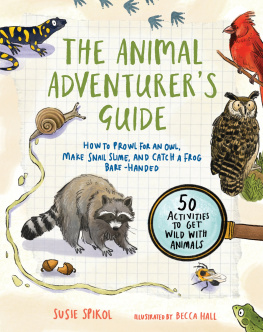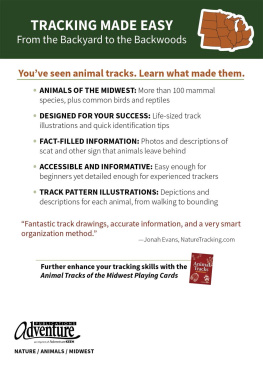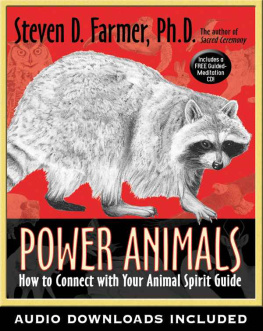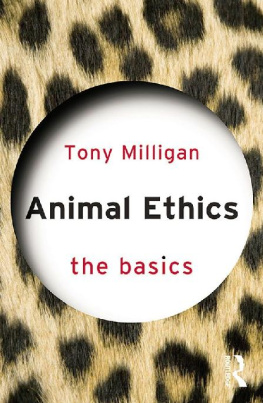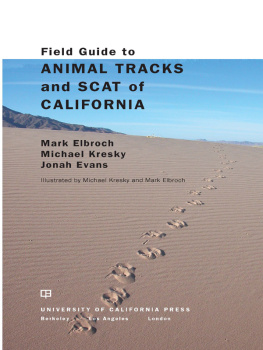
Copyright 2007 by Stackpole Books
Published by
Stackpole Books
5067 Ritter Road
Mechanicsburg, PA 17055
www.stackpolebooks.com
All rights reserved, including the right to reproduce this book or portions thereof in any form or by any means, electronic or mechanical, including photocopying, recording, or by any information storage and retrieval system, without permission in writing from the publisher. All inquiries should be addressed to: Stackpole Books, 5067 Ritter Road, Mechanicsburg, PA 17055.
Printed in the United States of America
10 9 8 7 6 5 4 3 2
First edition
Cover photograph of Grey Wolf Walking in Forest Corbis
Back cover photograph of Marsh Laura Flippen
Cover design by Wendy A. Reynolds
Photographs and illustrations by Tiffany Morgan unless otherwise indicated
Library of Congress Cataloging-in-Publication Data
Young, Jon, 1960
Animal tracking basics / Jon Young and Tiffany Morgan. p. cm.
ISBN13: 978-0-8117-3326-7
ISBN10: 0-8117-3326-2
1. Tracking and trailing. 2. Animal tracks. I. Morgan, Tiffany. II. Title.
SK282.Y68 2007 590dc22
2006012166
eBook ISBN 978-0-8117-4242-9
Acknowledgments
I have much appreciation for the animals that continue to live in harmony with the earth, particularly the bobcat and gray fox that have taught me much about the realities of their lives. The landscapes Ive tracked on have been just as instrumental in my understanding of animals as the animals themselves, so I thank the waters, soils, plants, trees, sun, moon, and stars for shaping and sustaining life.
I would like to thank Tom Brown Jr. and his tracking school for introducing me to tracking and inspiring in me a passion for following footprintsno matter how difficult the substrate. Tremendous thanks to co-author Jon Young and his Kamana Naturalist Training Program and Shikari Tracker Training Program, which taught me the importance of each animals unique relationship to the landscapeincluding my personal connection. White Pine Programs was instrumental in providing a community of trackers and naturalists with the shared passion of absorbing themselves, as well as our students, in the mysteries of the natural world; special thanks to Dan Hansche and Dan Gardoqui of White Pine for encouraging me to pursue my goals in tracking and nature studies even in a foreign place. The guidance of Mark Elbroch cemented my knowledge of animal track identification and gait analysis, which opened a pathway for the greater portion of my tracking knowledge to evolve.
Many people contributed to the creation of this book; I am grateful for the knowledge, expertise, and support of the following people: Paul Houghtaling for his dedication to the Shikari Tracker Training Program, which provided much of the inspiration and material for the creation of this book; the Riekes family provided me with a beautiful place to live in San Gregorio with an abundance of wildlife just outside my door; Terril Shorb edited and revised many of my personal tracking stories; Ken Clarkson provided photography and instruction for making soot trays; Doniga Markegard for her support and for sharing her expertise in utilizing camera traps; David Forthoffer for graciously offering his digital camera and photography skills; Karen Dvornich of NatureMapping for providing alternative soot tray instructions; Jonah Evans for his photographs of animal tracks and the tracker evaluation; Barry Martin for his enthusiasm in applying tracking in wildlife research and for his contribution to the chapter on tracking tools; Laura Flippen for offering her photography for the cover and accompanying me on a trip to the desert in the middle of summer; Walker Korby for his interest in how animals move and for offering his animal forms story; Travis Brown for his experience and knowledge related to live trapping small mammals; Louis Leibenberg for his contributions to the field of wildlife tracking and for including me in the first CyberTracker evaluation held in the United States; Wendolyn Bird for her support and for sharing her stories; Maureen McConnell for her encouragement over the years and for permission to use bird language graphics from the Boston Museum of Science bird language exhibit; Cara Burrow for listening and offering help during the editing process and for providing her house as a quiet refuge; Jeff Goldberg for renting me his cherished digital camera at the last minute; and the many people I have tracked with over the years for offering their insights and questions, which have undeniably added to the depth of my knowledge and the quality of my tracking experience.
The following people inspired in me the determination and enthusiasm to see this book through to completion. My father provided moral and financial support, which relieved me of other obligations, so I could meet deadlines. My mother encouraged me throughout the process with phone calls to inquire how the book was coming along. My twin sister, Nicole, continues to share with me an interest in the mysterious lives of animals, which makes tracking that much more gratifying. My sister Alison celebrated my accomplishments with me, which helped me value my work. Lori Damiano, through her friendship and caring, gave me the confidence to tell my stories. Although theyve passed on, Ernest Thompson Seton, Olaus Murie, and Ingwe have been constant inspirations for me in tracking as well as naturalist studies. Finally, I offer my deepest gratitude to my loving partner, Thomas Campbell, who helped me in every way possible to realize my dream of passing on this knowledge.
T.M.
Mathew and the One-Eyed Cat
It is a wholesome and necessary thing for us to turn again to the earth and in the contemplation of her beauties to know of wonder and humility.
Rachel Carson
T.M.
O ur goose was in the driveway, standing loyally by the side of his reflection in the mirrored surface of the Ford Expeditions bumper. He may have wondered why this other goose insisted on colliding beaks with him, to the exclusion of any other contact. More likely, he didnt wonder about this at all, and thats precisely why the relationship worked. Mathew, as we affectionately called him, flew in one afternoon, became instant chums with the tough-billed bumper goose, and put up with us humans walking back and forth across the driveway.
One day, three months after his arrival, I was working at my computer and could just see Mathew in my peripheral vision through a large window on the north side of the office. He had become like just another object in the yard, and then he made an alarming sound. Mathew was always vocal, to say the least, but this new vocalization was eccentric for him, so it piqued my interest. I lifted my chin and squinted my eyes to focus on the bird. He was taking quick, confused steps away from the car toward the office, as if he couldnt choose which direction to go, or whether to go at all. In hindsight, I wonder whether he was waiting for his imaginary friend to stick by his side. He held his head high and twisted, with one wary eye looking up and to the left while he made rapid squeaking honks. It clearly wasnt the same agitation he exhibited when a human approached; for that encounter, he took on a more defensive posture, hissing and extending his neck for ankles to nip. Gray foxes often visited the garden to eat compost on a nearby hillside, but they hardly got Mathews attention. Who or what was causing this odd behavior?
The shrill warning calls of Stellers jays began beating down from the trees with an unprecedented intensity. Instinctively rising out of my seat, I scanned the dark areas below the brush and trees surrounding the yard. A predator was moving into the area with the intention to kill. It emerged from behind the office, skirting the periphery down the east side of the driveway, swift and subtle. Moving stealthily into the shadow of a cluster of redwood trees, it crouched into a stalk and slithered up the woodpile to perch. It stood silent, neck outstretched and eyes riveted on the goose, its nub of a tail twitching methodically. It was a bobcat.
Next page

